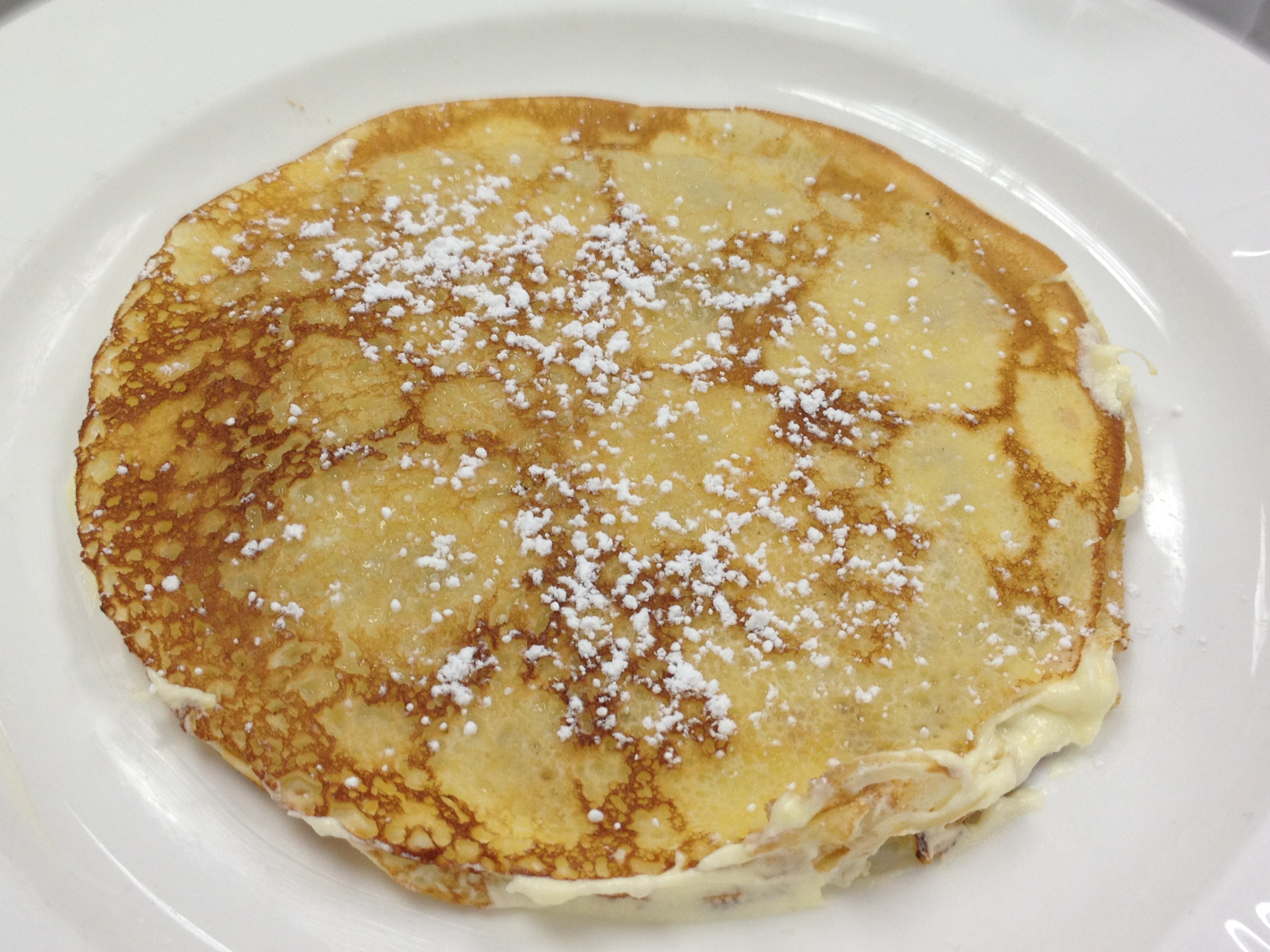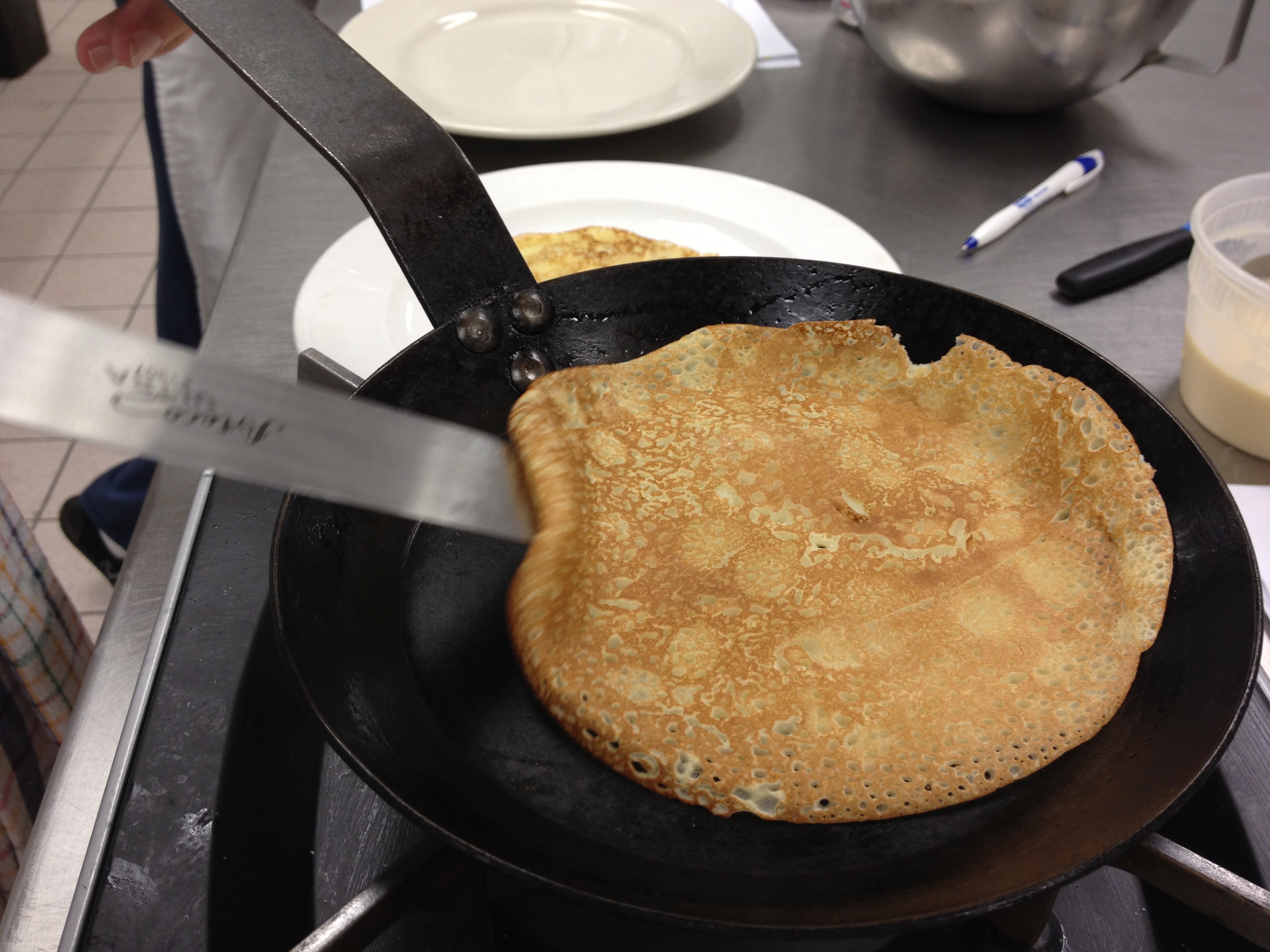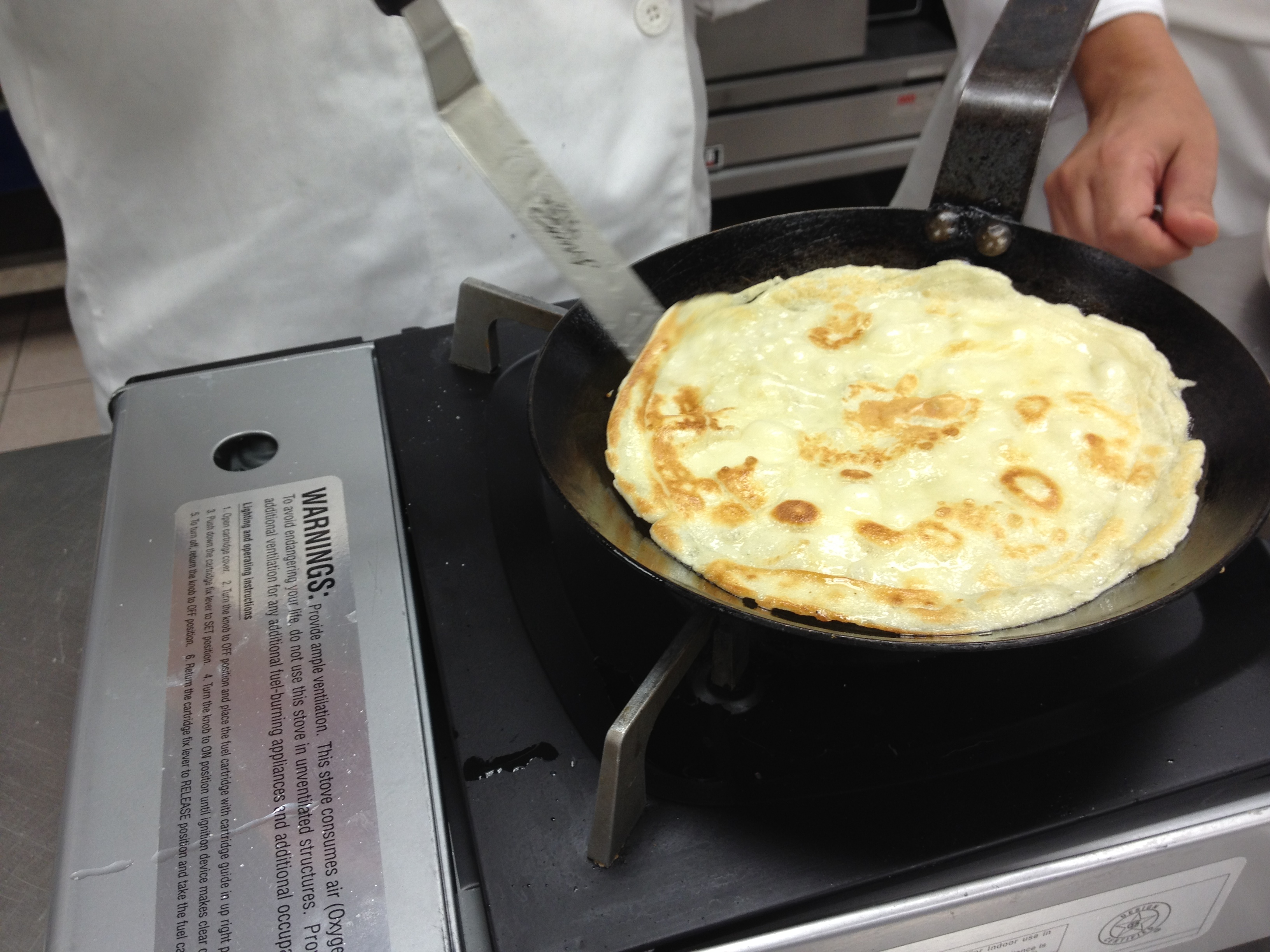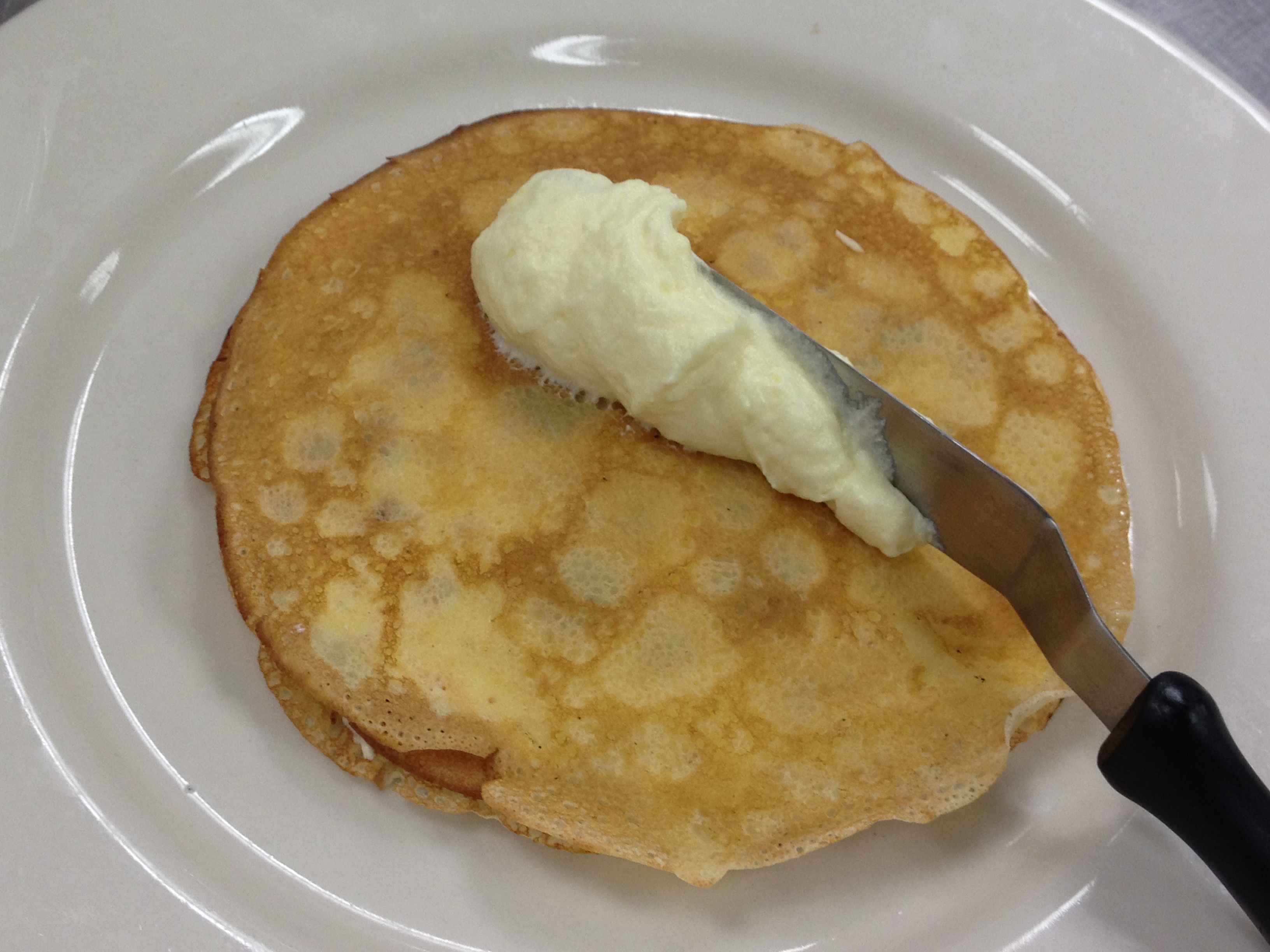I’ve fallen in love, and fallen hard.
Here is a picture of my beloved:
 Let me tell you about her. She is delicate and light, rich and ethereal all at once. She is, in a word, enchanting.
Let me tell you about her. She is delicate and light, rich and ethereal all at once. She is, in a word, enchanting.
Before you freak out and tell me you could never make crepes because they’re too difficult, let me jump in and tell you how easy and fun crepe-making is. The most challenging part of this recipe is making the buttercream, and that’s not technically difficult, it just takes a little time. But it’s so worth it. If ever you are going to trust me on something, trust me on this. Oh. My. God. Totally lovely.
Putting together this little miracle in pastry techniques class at L’Academie de Cuisine last night, we caught a huge break: Chef Claude made the buttercream for us. This dessert was just one of four we were making within three hours, so inevitably, some parts of the class are demonstration-only and some are things we do ourselves after chef schools us.
The buttercream in this recipe is not the classic type we’ve written about before, which starts with a meringue and absorbs tons of softened butter. This buttercream starts with pastry cream, and then adds the butter. The result is a creamy but very light buttercream. Wonderful!
You’ll probably want to have your buttercream finished by the time you finish making your crepes, so I’ll provide the recipes in that order. But since the fun photos are of the crepes, I’ll get to those first.
Making crepe batter is insanely easy. Here’s how: You combine all the ingredients in a bowl and mix. No steps 1, 2, 3, 4, and 5. Just one step: put it together and mix. You need to do this at least an hour ahead of when you want to cook the crepes, though; the batter needs time to rest.
Making the batter is so simple that we can move right on to cooking the crepes. Ideally, you want to use a crepe pan, but you can get by with an ordinary small sautee pan as well (it’s tougher, though). Heat the pan and coat it with a teensy bit of clarified butter. Make sure the pan is really hot before you pour in the batter. Then pour in the smallest amount necessary to coat the bottom of the pan as thinly as possible. We found a 1-ounce ladle works nicely for this. The crepe below is actually too thick; Chef Claude made a point of stopping by and telling us this with great disapproval. The pan is really hot, remember, so you want to hover there with a little offset spatula or whatever else you like to use, ready to flip this baby as soon as you see the top surface is set and the edges show a little brown on top. This one, below, isn’t quite ready yet.
The pan is really hot, remember, so you want to hover there with a little offset spatula or whatever else you like to use, ready to flip this baby as soon as you see the top surface is set and the edges show a little brown on top. This one, below, isn’t quite ready yet.
If you’ve cooked it long enough, it should look more like this when you flip it:
 This is quick work: from pouring to flipping takes only a few minutes, and then it’s another few until you lift the crepe from the pan and lay it out on a dish nearby to await its companions. The good news is that the crepes look much more delicate and fragile than they are. They are stretchy, accommodating little devils. Don’t push your luck, but don’t be afraid, either. It’s fun!
This is quick work: from pouring to flipping takes only a few minutes, and then it’s another few until you lift the crepe from the pan and lay it out on a dish nearby to await its companions. The good news is that the crepes look much more delicate and fragile than they are. They are stretchy, accommodating little devils. Don’t push your luck, but don’t be afraid, either. It’s fun!
Once all your crepes are made and stacked, wait until they’re cool and then coat each one with a thin layer of the lemon buttercream. Make a crepe–instead of a coat of buttercream–your top layer so you can shake a little powdered sugar over the top and show it off nicely.
You can stack this baby pretty high for drama; since we were short on time, we made stacks of only four. But you can imagine what a lovely presentation a higher stack would make for guests. And a neatly sliced little wedge would reveal all the pretty thin little layers. Can you tell I am thinking of planning a dinner party around this?
Some bakeries do versions of this; New York City’s Lady M, for instance, is well known for its mille crepe cake. It’s obvious that they are well aware of how lovely it looks sliced: They show it off on their website. Theirs is filled with pastry cream, though, rather than buttercream.
So here are your recipes. The buttercream recipe makes a lot, so you might want to reduce it. The crepes recipe produces 16 8-inch crepes.
Please, please, please make these! And enjoy.
Light Lemon Buttercream
18 eggs
Zest and juice of 6 lemons
17 oz. sugar
5 oz. unsalted butter, at room temperature
16 oz. heavy cream
13 oz. unsalted butter, at room temperature (yes, this is correct; another, separate portion of butter)
In a large saucepan, combine the eggs, zest and juice. Add sugar. Whisk together and cook over medium-high heat, watching very carefully to avoid burning. Whisk constantly to keep the mixture moving and prevent it from forming chunks or sticking to the bottom. When the mixture thickens and gives off its first couple of big “blurp” bubbles as it reaches a boil, take it off the heat and whisk in the 5 oz. of butter.
Pour the custard onto a lipped baking sheet lined with plastic wrap, and then cover it with another sheet of plastic wrap. Chill until it is room temperature or slightly cooler.
In a stand mixer with the whip attachment, whip the heavy cream until it holds stiff peaks. Empty it into a large mixing bowl.
In the empty bowl for the stand mixer, put the lemon cream and beat it for a couple of minutes on medium speed. Add the 13 oz. of butter, piece by piece, but steadily, not stopping until it’s all incorporated. Keep the mixer going until this mixture is light and smooth.
Remove the cream from the stand and fold in the whipped cream.
Crepes
1 egg
1 egg yolk
4 oz. all-purpose flour
salt
1 oz. sugar
1 c. milk (you might need a little more to thin the batter if necessary)
2 oz. clarified butter, at room temperature (you can substitute oil)
Combine all ingredients except the clarified butter in a mixing bowl and whisk to combine. Let rest for at least an hour before cooking crepes; a full day’s rest in the refrigerator is best.
When ready to cook, follow instructions posted above with the photos.






Thanks for sharing these with me at class last night. I can personally attest to their lemony deliciousness! I think this would make a lovely spring or summer dessert and I will definitely be trying it. Thanks for sharing!